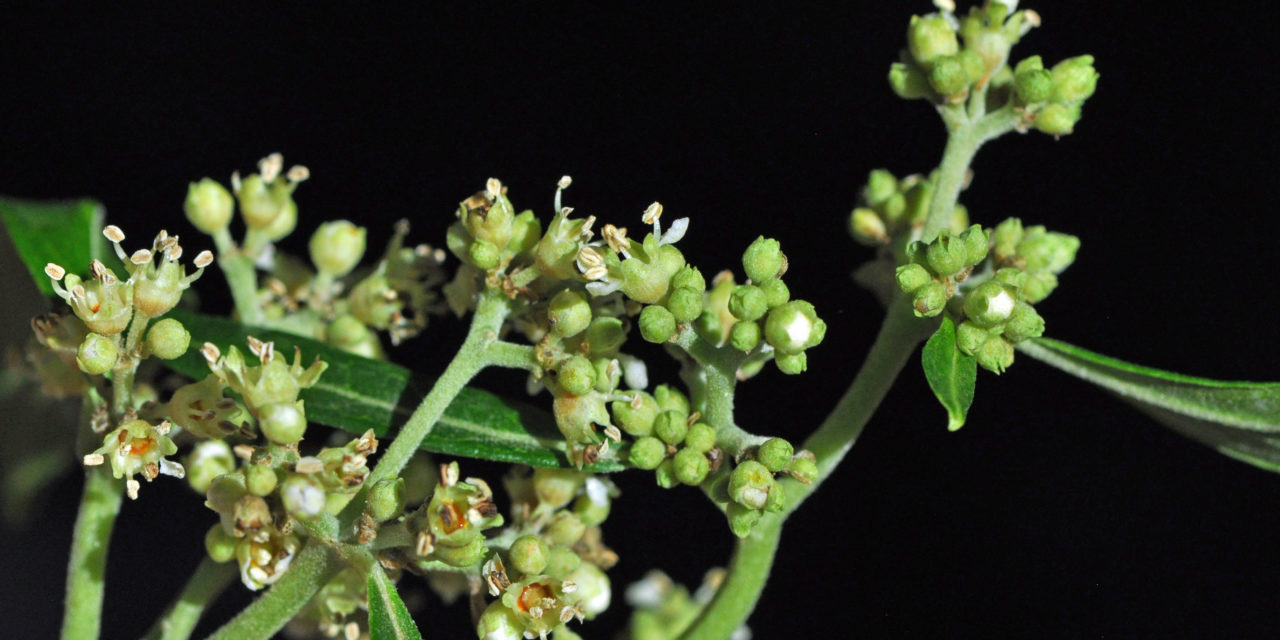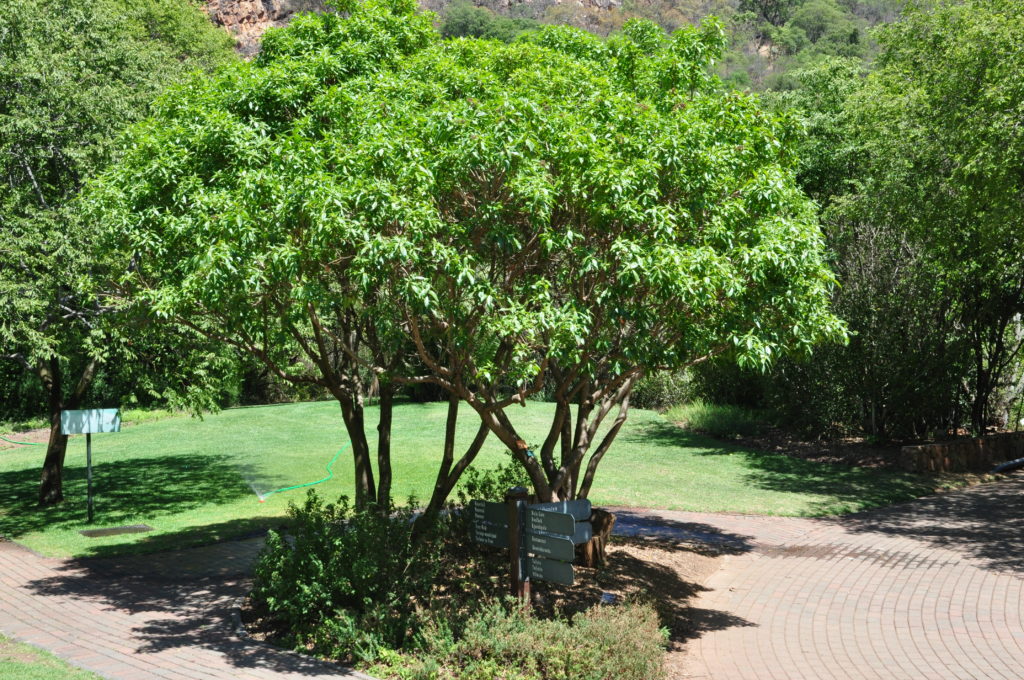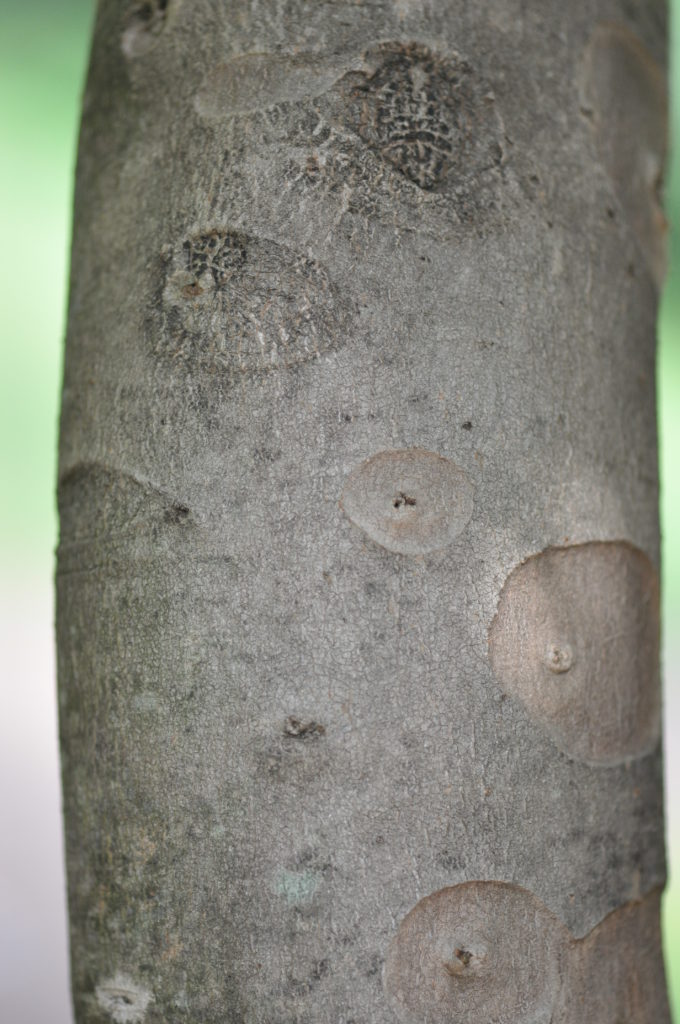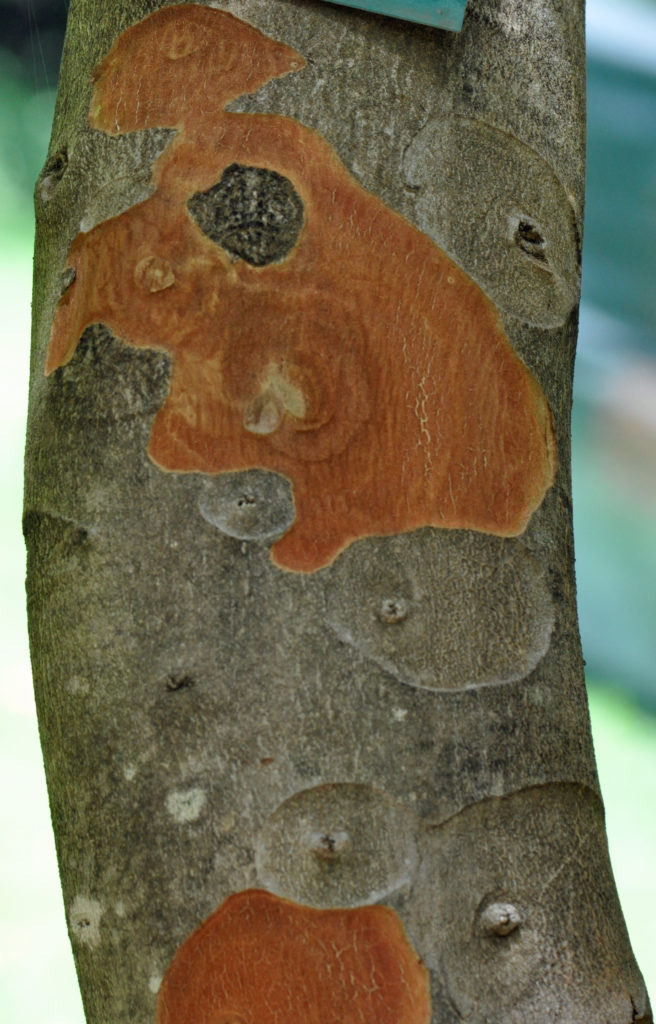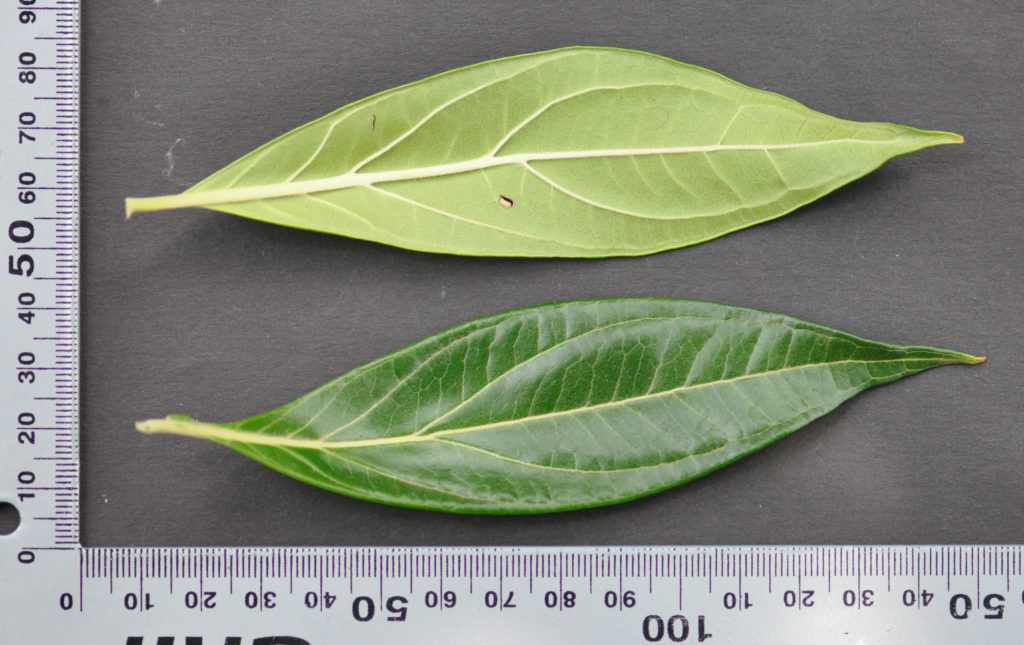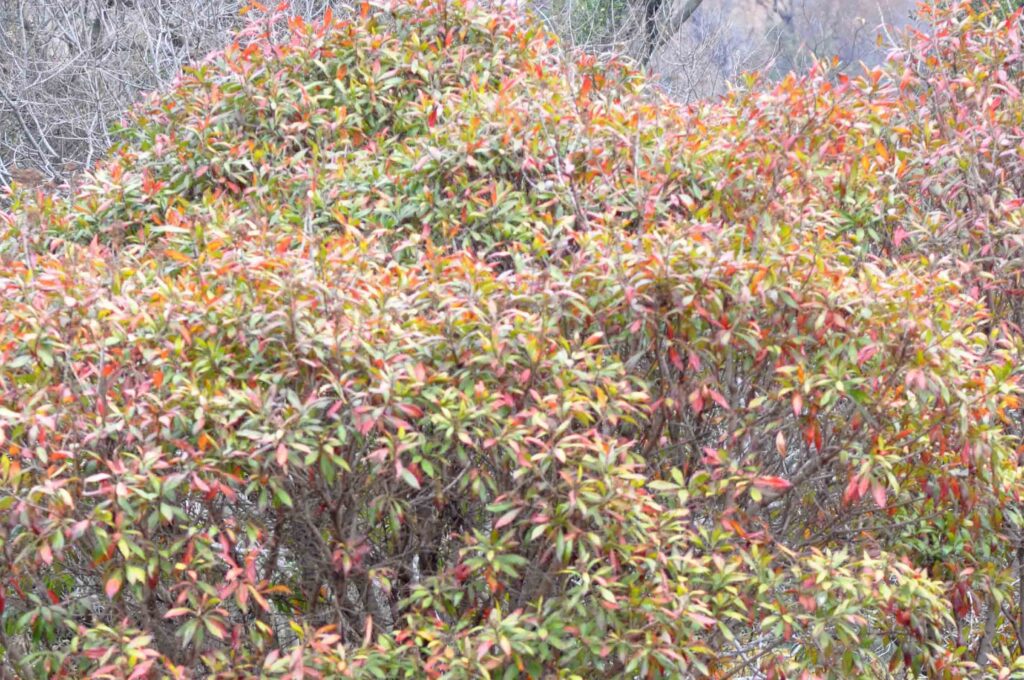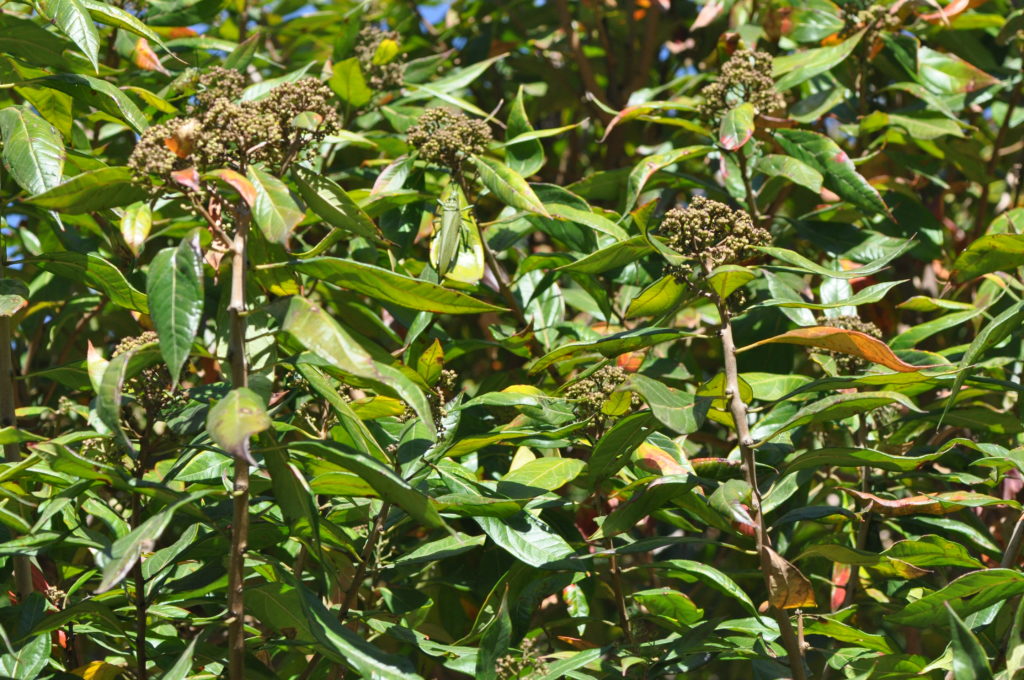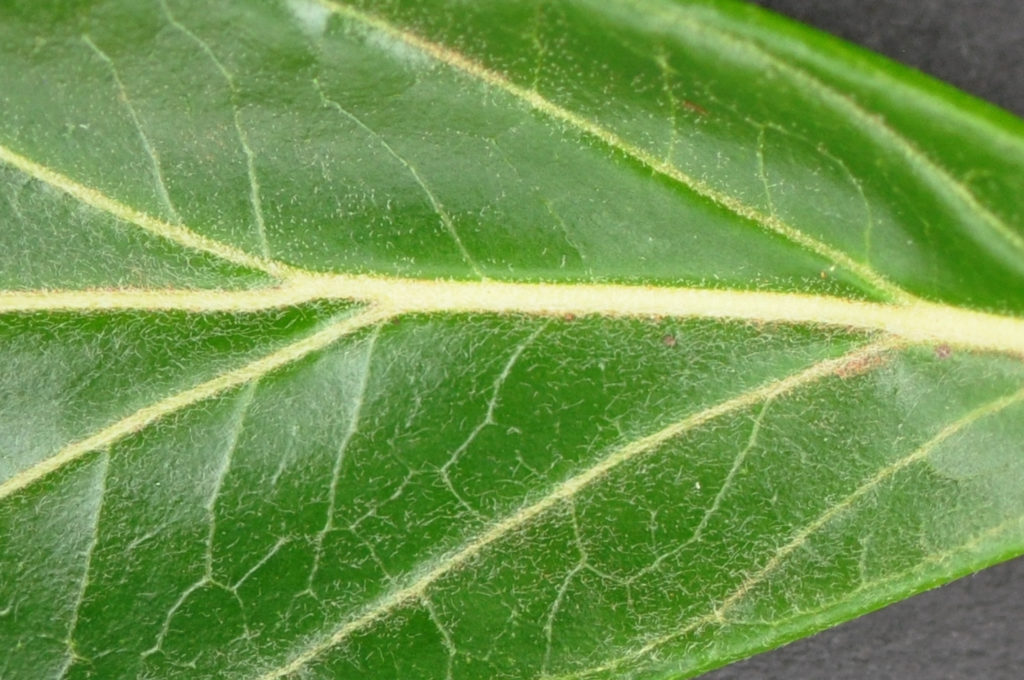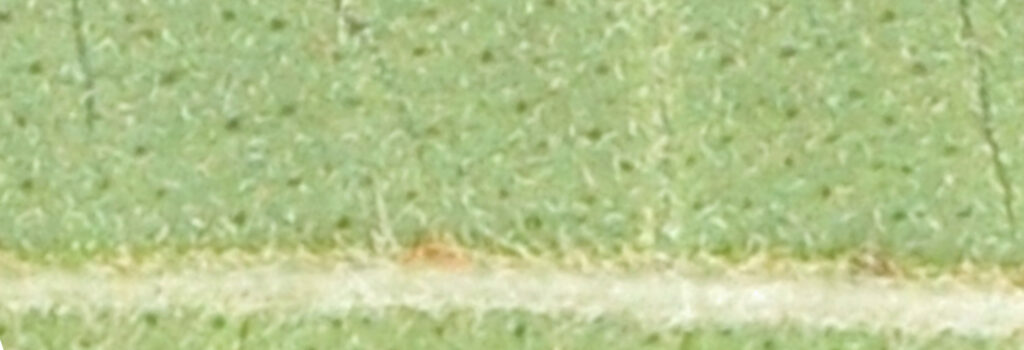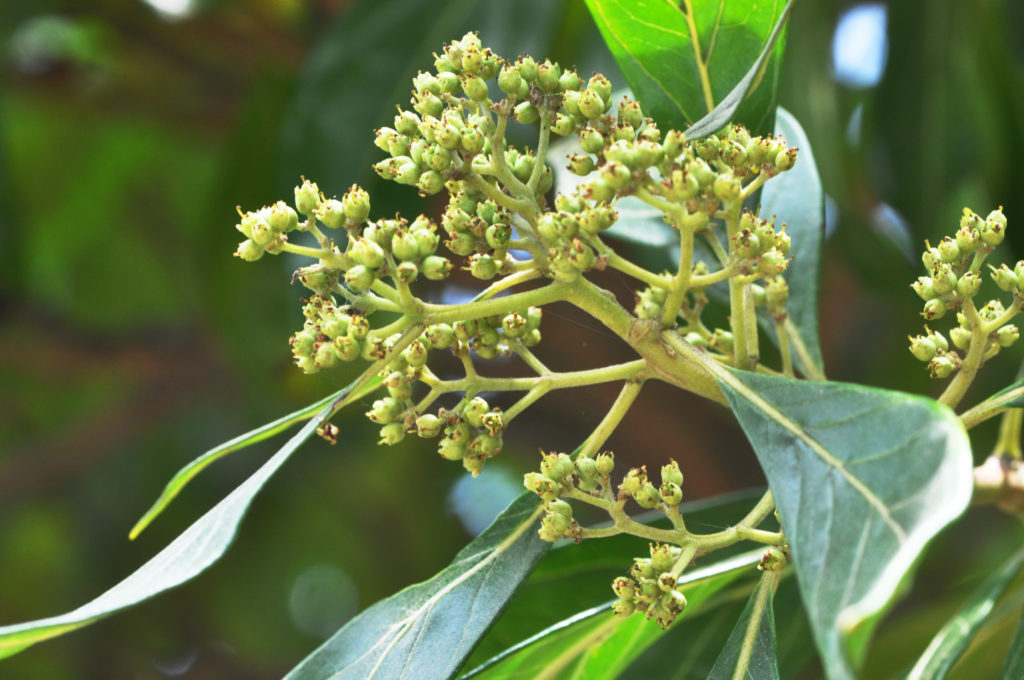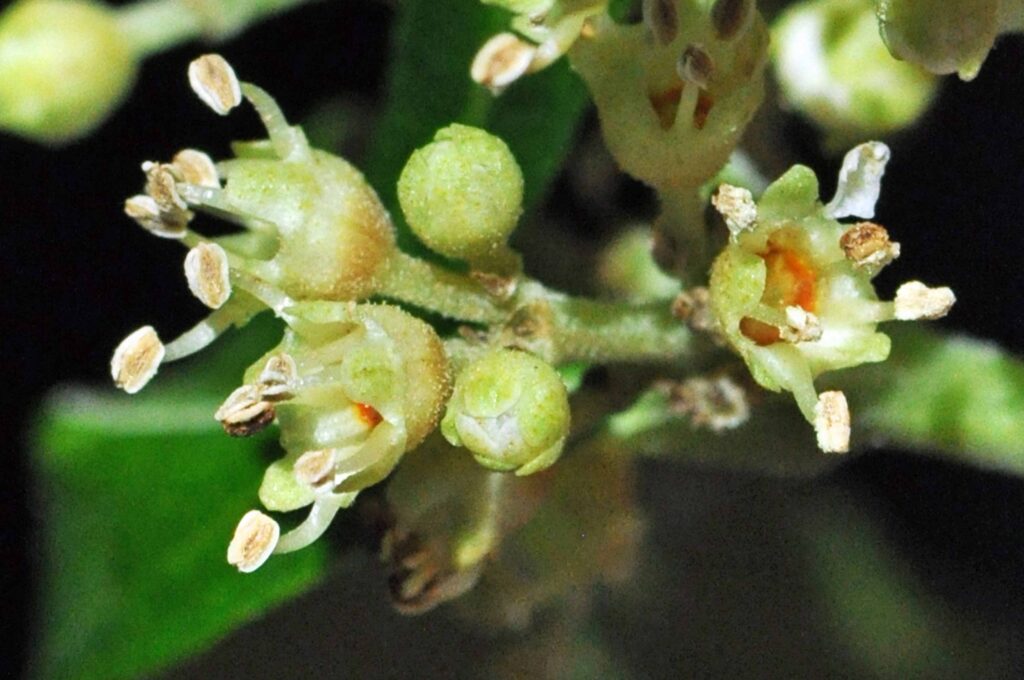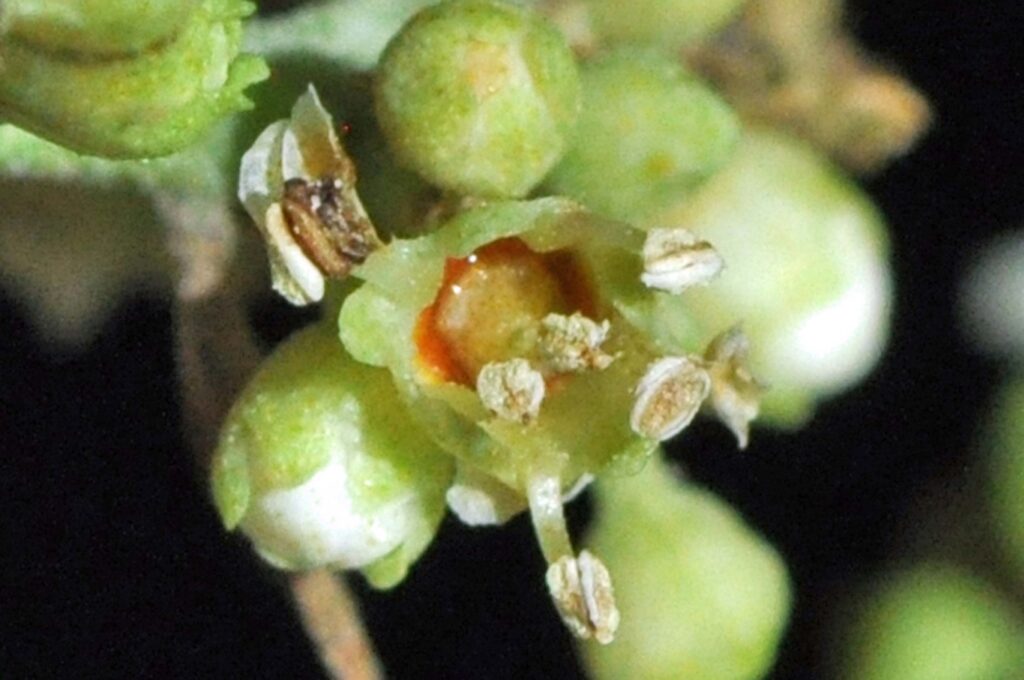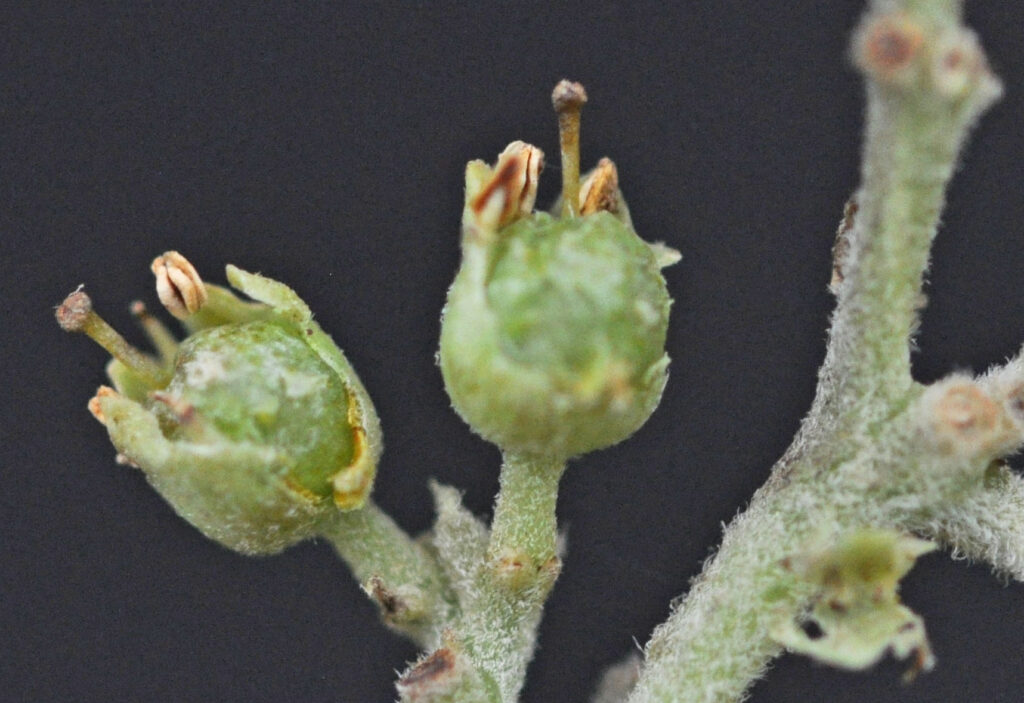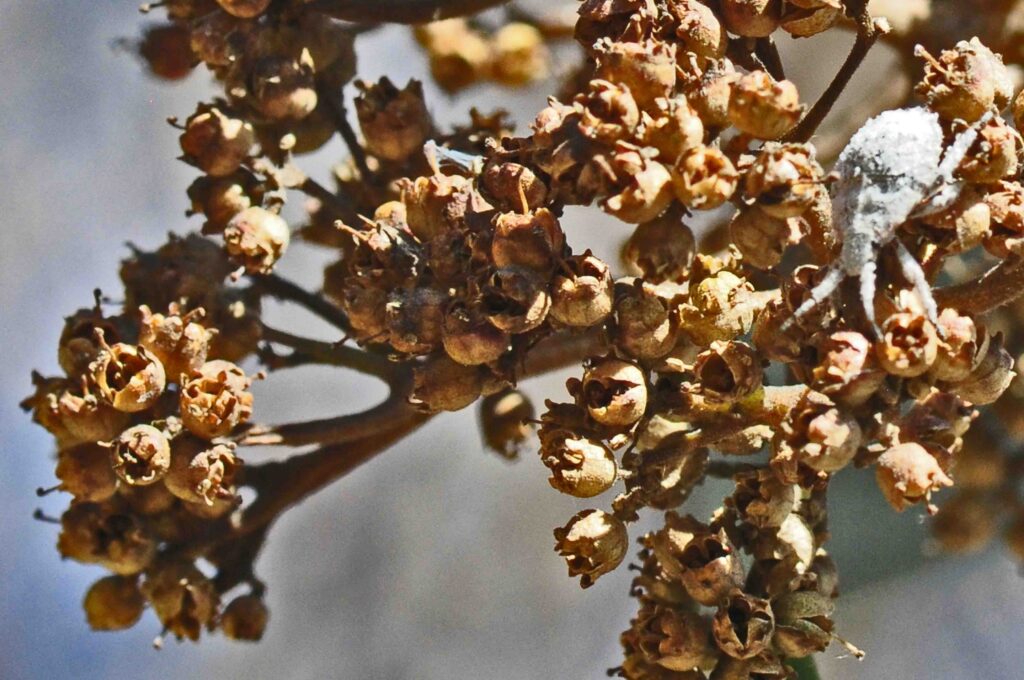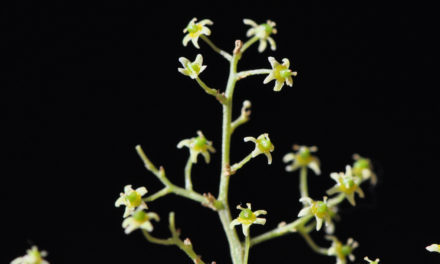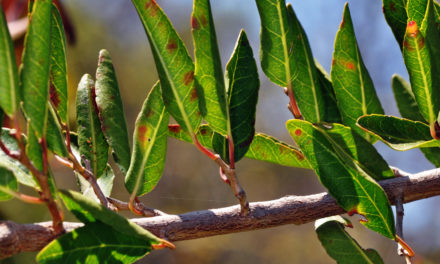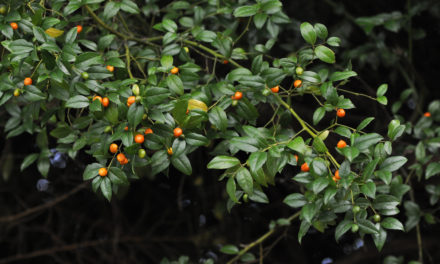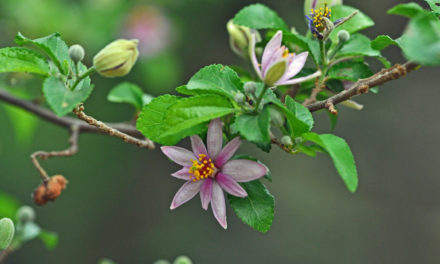General Info – summary
This Tree is up to 15m high, with a straight or twisted trunk. Simple gland dotted aromatic Leaves lack stipules and are entire. Secondary veins arch towards the apex. Small whitish, 5-merous, scented and bisexual Flowers are in dense panicles. The 5 stamens have free anthers & the 2-locular ovary has 1 short style + a capitate stigma. Fruit is a small, almost spherical capsule containing small slightly winged seeds.
Heteropyxis canescens
Previous Names: Heteropyxis transvaalensis.
SA Tree No. 454.
Common names: (Afr) Boslaventelboom. (Eng) Lavender Tree, Forest Lavender-tree. (siSwati) Inkunzana.
Family (Heteropyxidaceae) Myrtaceae (Myrtle and Eucalyptus family) has 130+ genera and 3 000+ species and includes the Australian genus Eucalyptus, as well as guava and clove. These mostly evergreen trees have simple Leaves that are leathery, usually entire, gland-dotted and usually opposite. Stipules are very small or absent. Flowers are regular usually bisexual and 4 or 5-merous. However, petals may be small or absent. The many Stamens are inflexed in the bud and Anthers are 2-thecous (with 2 pollen sacs). They usually open by lengthwise slits. The usually inferior Ovary has a simple Style with a capitate Stigma. The Fruit is a capsule or berry with a persistent Calyx. Local genera with trees on this website include Eugenia, Heteropyxis, Metrosideros (Western Cape) and Syzygium.
Name derivation: Heteropyxis – distinct or different with a box like lid – referring to the capsule. canescens refers to ashen-grey – colour of hairs found on branches and lower side of leaves.
Conservation: National Status: L C. (Least Concern). Assessment: 2005 (J.E. Victor). Note: this is a rare plant.
Tree
The Tree usually has a single, upright Trunk that branches high up (photo 240). It is a relatively narrow and usually 3-8m high tree but may reach 15m or more. The trunk may be straight or twisted. The Bark is silvery grey to brown (photo 993) most of the year. In early summer the bark flakes off in more or less oval discs, exposing attractive big pinkish blotches of the underbark (photo 186). This is similar to what occurs in Podocarpus falcatus. These blotches darken rather quickly and become grey with time (photo 993). Young branches have fine grey hairs.
- 240. 2014/10/21. Walter Sisulu NBG. Photo: David Becking.
- 993. 2014/04/01. Walter Sisulu NBG. Photo: David Becking.
- 186. 2015/12/08. Walter Sisulu NBG. Photo: David Becking.
Leaves
The leathery and usually alternate, or spirally arranged Leaves are simple (has a single blade which may have incisions that are not deep enough to divide the blade into leaflets). Leaves are narrowly elliptic to elliptic and up to 15 x 3,5cm (photo 192). Thus, they may be longer than those in Heteropyxis natalensis. Occasionally a red, orange or yellow leaf may appear. This weather dependent tree is evergreen or semi-deciduous. The leaves may change to an impressive orange/red after a cold spell (photo 816). The Upper surface is shiny (photo 132), dark green and hairless (photo 192). When the lighter green Lower surface is observed with a hand lens, gland dots and the persistent leaf hairs are visible (photos 194 & 193). In photo 192, the Secondary veins are raised and prominent. They may be slightly pink, form an acute angle with the midrib then curve to follow the margin towards the apex (photo 192). Net veining is loose. The Apex tapers narrowly and may form a drip tip. The Base is narrowly tapering. The rolled under Margin is entire (with a continuous margin, not in any way indented – photo 192). Petioles (leaf stalks) are up to 1,4cm long (photo 192). Stipules (basal appendages of the petiole) are rudimentary or absent. Crushed leaves are aromatic.
- 192. 2014/12/02. Walter Sisulu NBG. Photo: David Becking.
- 816. 2015/08/11. Walter Sisulu NBG. Photo: David Becking.
- 132. 2014/06/03. Walter Sisulu NBG. Photo: David Becking.
- 194. 2014/12/02. Walter Sisulu NBG. Photo: David Becking.
- 193. 2014/12/02. Walter Sisulu NBG. Photo: David Becking.
Flowers
The scented, small, white, cream or yellow-green Flowers develop at branch ends in dense terminal Panicles (indeterminate, branched inflorescences with stalked flowers – photo 563). Each flower is about 3mm long and rests on a soft, hairy Pedicel (stalk of a single flower – photo 34). Here orange nectaries are visible. Flowers are actinomorphic (Regular, symmetrical. They are vertically divisible into similar halves by more than 1 plane passing through the axis) and perigynous (having sepals, petals, and stamens at the same level as the carpels: halfway up the superior ovary). The Calyx is cup-shaped with 5 persistent and imbricate sepals (having regularly arranged, overlapping edges, as roof tiles or fish scales – photo 34). These lobes are persistent (photo 16 under Fruit). The Corolla has 5 Petals that are imbricate. These arise from the inner rim of the Hypanthium (the cup-like receptacle usually derived from the fusion of floral envelopes and androecium, and on which are seemly borne: the calyx, corolla and stamens). Petals are gland-dotted and fall away very early – some just visible in photo 34. Male and female flowers are on different plants. The Male Flowers have 5 free Stamens with 2-locular Anthers which eventually extend beyond the sepals (photos 39). Pollen grains are just visible on the RHS anther of this photo. In the Female Flowers, the Pistil (a unit of the Gynoecium, the female element of the flower, composed of the Ovary, Style and Stigma) has a 2-locular Ovary that is almost spherical and contains numerous ovules. It ends in a capitate (head-like) Stigma with a short Style (photo 16 under Fruit). Minute staminodes are present. (Sep-Mar).
- 563. 2014/03/06. Walter Sisulu NBG. Photo: David Becking.
- 34. 2016/12/06. Walter Sisulu NBG. Photo: David Becking.
- 39. 2016/12/06. Walter Sisulu NBG. Photo: David Becking.
Fruit
The small, light brown, almost spherical Fruit is a Capsule (a dry fruit resulting from the maturing of a compound ovary, which usually opens at maturity by one or more lines of dehiscence). This capsule, which just protrudes past and, is partly enclosed by the persistent Calyx (photo 16), measures up to 3 x 3mm. The fruit pedicel is short and covered with soft grey hairs (Photo 16). On this photo, the remains of the Stamens as well as the Style and capitate Stigma are visible. The very small Seeds are brownish, slightly winged and 3-angled. (Feb-Jul).
- 16. 2018/03/07. Walter Sisulu NBG. Photo: David Becking.
- 981. 2014/08/05. Walter Sisulu NBG. Photo: David Becking.
Distribution & Ecology
This Tree is somewhat rare and found in forests and ravines. It is only found in Eswatini (Swaziland) and Eastern mountains of Mpumalanga e.g., Barberton. These plants are thus Endemic in southern Arica (Endemism is the ecological state of a species being unique to a defined geographic location). They grow in moist areas, in full sun and in altitudes ranging from 730-1 600m. Flowers attract insects, including butterflies, bees and wasps. The small flower size suggests that the agents of pollination are small insects that are attracted by the nectar. Keep plants moist in summer. Growth rate is about 1m per year. Young plants are sensitive to severe frost.
Ethnobotany
This is a good Garden tree prospect. It can tolerate some frost and survives infrequent droughts but not extremely dry areas. Roots are relatively trouble free. Propagation is from fresh seeds. It is moderately fast growing – about 1m per year. Plant fresh seeds in spring in a shady area–and transfer plants to a sunny location. Planting a number of these small plants to grow together is impressive – if there is sufficient space (photo 240 under Tree). This plant does well in a container.
References
Boon, R. 2010. Pooley’s Trees of eastern South Africa. Flora and Fauna Publications Trust, Durban.
Coates Palgrave, M. 2002. Keith Coates Palgrave Trees of Southern Africa, edn 3. Struik, Cape Town.
Lawrence, G. H. M, 1951. Taxonomy of Vascular Plants. The Macmillan Company, New York. Tenth Printing 1965.
Palmer, E. & Pitman, N. 1972. Trees of southern Africa. Balkema, Amsterdam, Cape Town.
Schmidt, S. Lotter, M. & McCleland, W. 2002. Trees and Shrubs of Mpumalanga and the Kruger National Park. Jacana, Johannesburg.
van Wyk, B. & van Wyk, P. 1997 Field guide to Trees of Southern Africa. Struik, Cape Town.
Victor, J.E. 2005. Heteropyxis canescens Oliv. National Assessment: Red List of South African Plants version 2020.1. Accessed on 2023/07/16.
http://www.plantbook.co.za/heteropyxis-canescens/
http://posa.sanbi.org/flora/browse.php?src=SP
http://www.ipni.org and http://apps.kew.org/wcsp/

